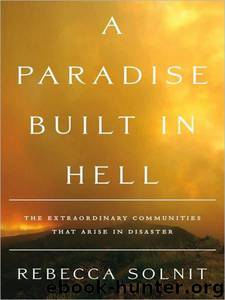A Paradise Built in Hell by Rebecca Solnit

Author:Rebecca Solnit
Language: eng
Format: mobi, epub
Tags: Non-fiction
ISBN: 9780143118077
Publisher: Penguin Group (USA)
Published: 2009-08-20T10:00:00+00:00
The City Belongs to Everyone
Lucha libre means Mexico’s theatrical version of wrestling, but the word lucha is less specific than the English word wrestling: it means struggle and it is used in a political sense all the time. Lucha libre, free struggle, the enormously popular Mexican sport, serves as entertainment with symbolic and political dimensions, a carnival of masculine power and imaginative adventure. Like most sports, lucha libre serves as a drama with an unknown outcome for the conflicts between the tecnicos, good guys who play by the rules, and rudos, who cheat and generally embody evil. The wrestlers are always masked, anonymous, with stage names that have no ordinary names behind them, and so they parade like the figures in a carnival, dressed as gods, heroes, animals, and myths of the past. Among the best-known names are Blue Demon, the Black Shadow, and Thousand Masks. To unmask a wrestler is to defeat him definitively, and wrestlers sometimes compete for their tight-fitting, face-covering headpieces with letters, emblems, or colors that reflect the superhero names of the wrestlers. Ripping another wrestler’s mask off is grounds for disqualification.
The most celebrated of all Mexican wrestlers was the silver-masked El Santo, the Saint, whose career spanned four decades, countless victories in the ring, fifty-two films, mostly science fiction and monster movies, and a lot of comic books. A week before he died, he pulled his mask back to reveal his face on television, but he was buried with the mask on. Lucha libre is the most carnivalesque of sports, depending on disguise and transformation, embodying metaphysical concerns about power, ethics, and justice.
Until 1987, many wrestlers’ careers overflowed the ring into pop culture, but one wrestler came from far outside the ring to wrestle with injustice. Super Barrio emerged from the ruins of the 1985 earthquake, or rather from the lucha, the struggle that came out of the earthquake. When politicians cut ribbons or staged other public events they hoped would reflect well on them, Super Barrio would show up and pressure them to do better by the poor. He confronted landlords; showed up at evictions, meetings, and demonstrations; inspired the strugglers to feel more powerful and confident. He became famous as a sort of latter-day Robin Hood of the urban poor, and he lives on more than two decades after he first appeared. He is credited with stopping ten thousand evictions, and when he appeared on camera in a recent documentary he spoke about his politics in such phrases as, “We have asserted that the city belongs to everyone” and “The credit goes to the people. Who is behind the mask matters least” and “Super Barrio is all of us.” Though the only one in costume, he placed everyone around him in carnival mode and opened up the possibilities.
Several men have worn the tight red-and-yellow outfit with the big SB on the chest, but only one man is publicly identified with Super Barrio: ex-revolutionary, former prisoner, La Jornada columnist, tenant organizer, and restaurateur Marco Rascón.
Download
This site does not store any files on its server. We only index and link to content provided by other sites. Please contact the content providers to delete copyright contents if any and email us, we'll remove relevant links or contents immediately.
Rewire Your Anxious Brain by Catherine M. Pittman(17619)
Talking to Strangers by Malcolm Gladwell(11953)
The Art of Thinking Clearly by Rolf Dobelli(8897)
Mindhunter: Inside the FBI's Elite Serial Crime Unit by John E. Douglas & Mark Olshaker(7873)
Becoming Supernatural by Dr. Joe Dispenza(7142)
Change Your Questions, Change Your Life by Marilee Adams(6684)
The Road Less Traveled by M. Scott Peck(6671)
Nudge - Improving Decisions about Health, Wealth, and Happiness by Thaler Sunstein(6667)
The Lost Art of Listening by Michael P. Nichols(6511)
Enlightenment Now: The Case for Reason, Science, Humanism, and Progress by Steven Pinker(6434)
Win Bigly by Scott Adams(6341)
Mastermind: How to Think Like Sherlock Holmes by Maria Konnikova(6275)
The Way of Zen by Alan W. Watts(5828)
Daring Greatly by Brene Brown(5679)
Big Magic: Creative Living Beyond Fear by Elizabeth Gilbert(4762)
Grit by Angela Duckworth(4760)
Men In Love by Nancy Friday(4366)
Flow by Mihaly Csikszentmihalyi(4078)
The Four Tendencies by Gretchen Rubin(4042)
